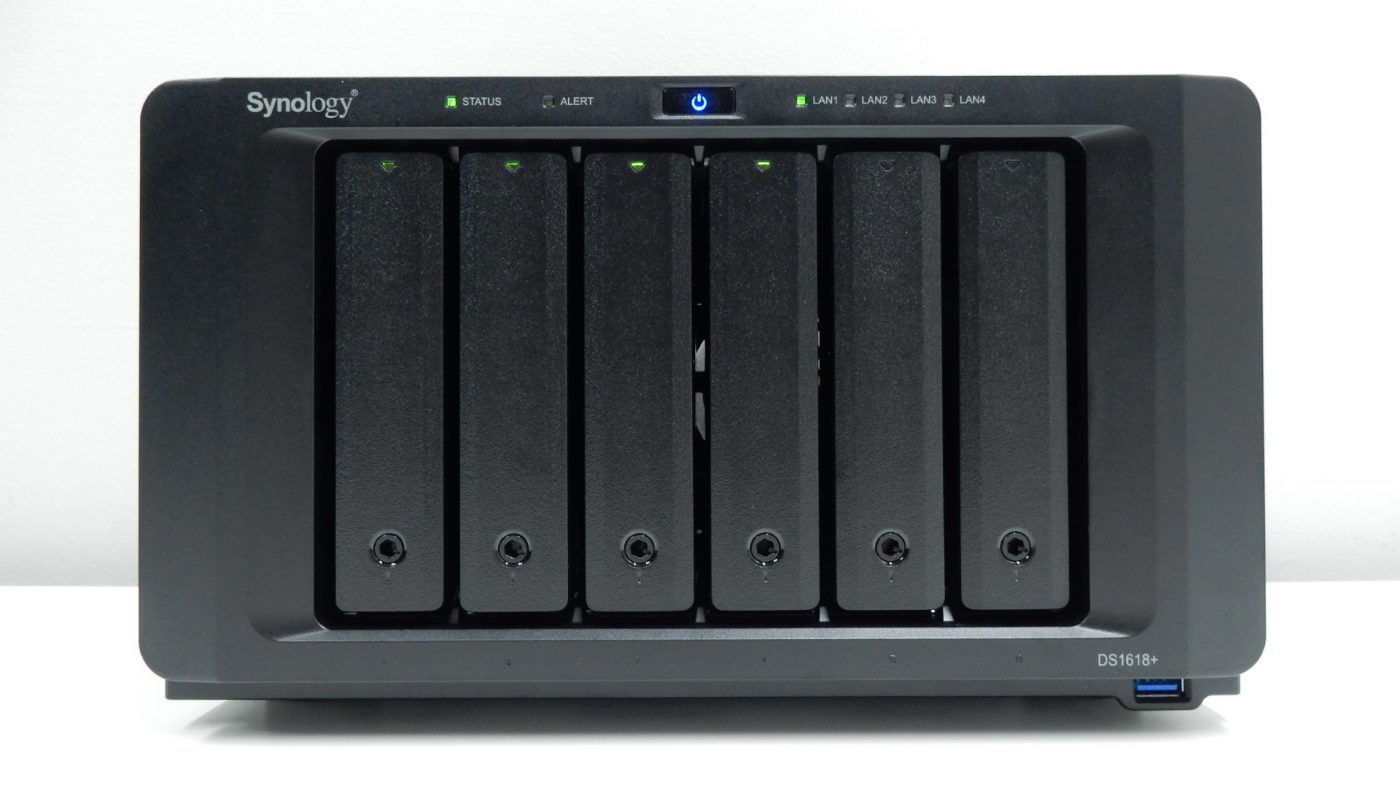Synology DiskStation DS1618+ Overview
Being a 6-bay unit, the DS1618+ takes up a considerable amount of desk space, with external dimensions of 166mm x 282mm x 243mm. With an empty weight of 5.05kg, moving the DS1618+ around is no challenge; put in six 3.5″ drives, and the unit becomes downright hefty, so be sure to place it on a sturdy surface. As we mentioned earlier, a quad-core Intel Atom C3538 is on compute duty and an included 4GB of DDR4 is in place for memory duties. With room for up to two SO-DIMMs, memory capacity is capped at 32GB; plenty for standard file sharing duties, as well as serving up other functions like a Plex server and virtual machine hosting.
From the front, the DS1618+ looks like many other previously released Synology units. Centered on the front facade are the six removable drive trays, each with an LED indicator at the top, and a lock at the bottom.
Above the drive trays, from left to right, are Status and Alert LED indicators, the Power button, and LAN1-LAN4 LED indicators.
A single Type-A USB 3.0 port is situated at the bottom right corner of the NAS and can be used to connect additional external storage drives or even a printer for sharing on the network. A simple DS1618+ model indicator is located near the bottom right corner, and molded drive numbers are located beneath each drive bay.
Each side of the DiskStation DS1618+ features passive air intakes via a cutout in the shape of “Synology”. A mesh grille material is directly behind these cutouts to offer some dust and external hazard protection, and we really like this dual-purpose design that tackles both aesthetic and thermal duties.
Out back we find ourselves with a load of connections and features that start to give you a good idea of just how robust the DS1618+ is, if the six-bay nature of the unit wasn’t enough of an indicator. Situated half-way down the unit and on the left side is a sunken power connector that allows the power cable to sit further within the unit than most standard power supplies. We like this design, but would have loved to see some way of securing the cable to the opening to prevent accidental unplugging. Speaking of securing, a standard Kingston lock slot is placed below the power connector. Slightly off-centered are two 92mm fans that can operate in three different modes: Full-Speed, Cool, and Quiet. These fans are easily accessed and replaced via their removable fan bracket, so swapping them out for repair or replacement with quieter models should be a breeze. On the right side of the NAS is a single PCIe expansion slot that can be populated with add-in cards like a 10GbE NIC or an internal M.2 SSD card for caching.
Along the bottom portion of the rear of the DS1618+ we find multiple data and network connectivity options. Starting from the left we have the first of two eSATA ports. While there may be some users that take advantage of these ports, we would have liked to see even a single Type-C USB 3.1 port in their place. Next up are four 1GbE RJ-45 ports which can be teamed to provide additional throughput for the NAS. A recessed RESET button is available for those troubled times when you just need to start from scratch. Two Type-A USB 3.0 ports are also available to connect an array of optional devices, and last up is the second eSATA port.
Flipping the unit over is quite unremarkable, other than a small access door that can be removed to access the system’s memory. A single 4GB SO-DIMM of 2133MHz DDR4 comes pre-installed in the DS1618+, but you can utilize both slots to equip this NAS with up to 32GB of RAM, allowing you much more headroom for things like virtual machines and other memory-heavy loads.











